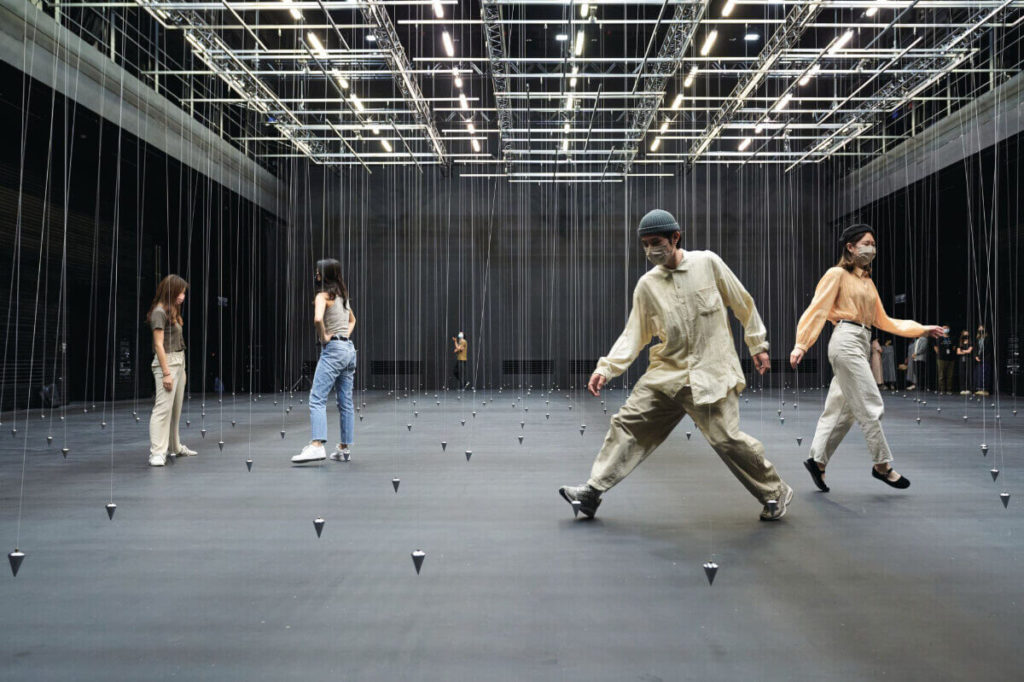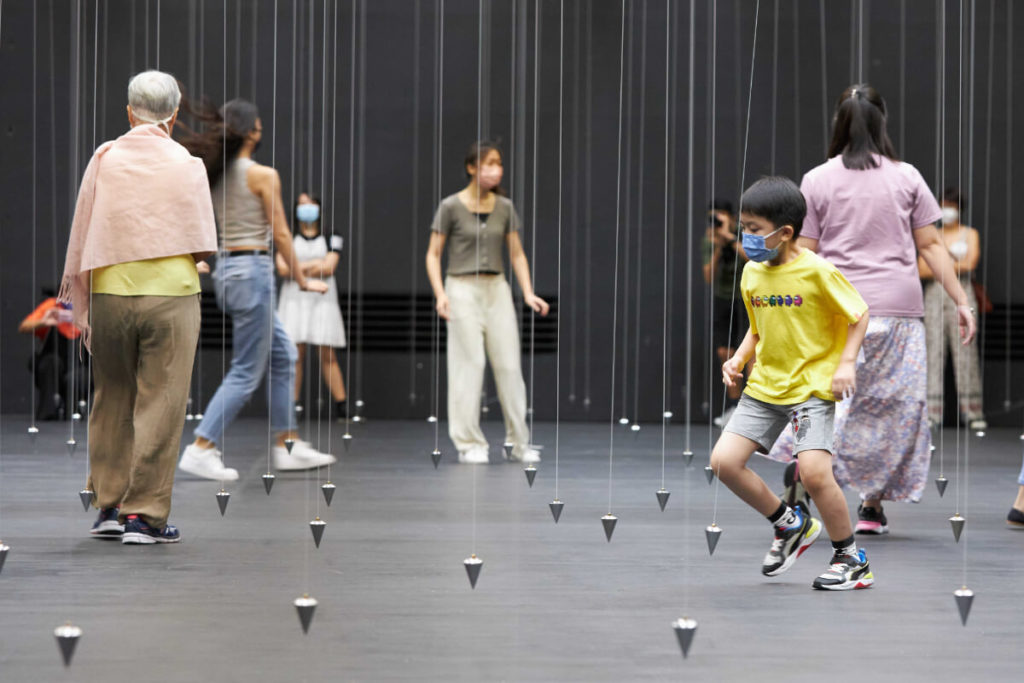American choreographer William Forsythe (b. 1949 in New York) has been choreographing works from the 1970s to the present day. He is widely regarded as one of the most important choreographers of the late 20th century to reform the art of dance, particularly ballet. Forsythe’s work has emphasised the technical and conceptual rethinking and development of ballet. His long and productive career has focused on Europe, where his work has long been recognised as significant and provided with the conditions to create.
William Forsythe first studied in Florida and in 1969 moved to the Joffrey Ballet School in New York. He had a contract in Joffrey Ballet as a dancer, but already in 1973 he was accompanying his then wife Eileen Brady to the Stuttgart Ballet in Germany. It was in Stuttgart that his work as a choreographer began in 1976 with a short piece, Urlicht, which was enthusiastically received and quickly led to further commissions, both for the Stuttgart Ballet and around the world. Forsythe grew into a prolific choreographer who developed recognisably original works and significantly reformed the aesthetics of ballet. In 1984, Forsythe was appointed Artistic Director of Ballett Frankfurt, a post he held until 2004. One if his major internationally renowned works was In the Middle, Somewhat Elevated, created for the Paris Opera Ballet in 1987.
From Balanchine towards Postdramatic Theatre
In his early works, Forsythe developed the neoclassical ballet of the Americanised, originally Georgian choreographer George Balanchine (Georgiy Balanchivadze, 1904–1983). Balanchine was passionate about developing ballet technique. He saw that the dancer’s task was to execute often very demanding sequences of movements to create an impression of intensity and grace, but he did not want the dancers to convey their thoughts or feelings in the choreography. Although Balanchine’s more abstract works often contained elements of plot, Susan Leigh Foster says that while narrative provides the theme for Balanchine’s works, the real focus of the ballets lies in visual thinking, movement composition and musical interpretation.[1]

Forsythe’s appointment as director of the Frankfurt Ballet coincided with a boom, enabled by the city’s growing funding for the cultural sector.[2] At the same time, the performing arts scene in Western Europe as a whole and what was then West Germany was going through a lively period of change: the independent scene was gaining ground, new venues were opening and scenic expression was renewing. Hans-Thies Lehmann sees self-reflexive process and structure as key in this context.[3] According to him, the new theatre is characterised by a constant exploration of its own being as a (theatrical) linguistic entity, no longer as a dramatic theatre text. Originally published in Germany in 1999, Lehmann’s Postdramatisches Theater (in English 2006) identifies 11 features in which the new theatre differs from the old: parataxis/non-hierarchy, simultaneity, play with the density of signs, plethora, musicalisation, scenography, visual dramaturgy, warmth and coldness, physicality, “concrete theatre,” irruption of the real and event/situation. Lehmann calls this new style postdramatic theatre. In what follows, I look specifically at the career of William Forsythe, but similar observations can be made about the relationship to staging and the distinction between choreographic composition and dance in the work of other important contemporary choreographers, such as Pina Bausch and Meg Stuart.
The analytical and critical approach described above characterised Forsythe’s work in the 1980s. According to Gerald Siegmund, the works of this period explore the history of ballet, its mechanisms of transmission, the conventions of the stage and the ways in which works are received.[4] Forsythe’s first work for the new Ballett Frankfurt company was Artifact in 1984. It is still considered his paradigmatic work, in which Forsythe brings characters, text as material, music and other theatrical elements to the stage in a way that appears “sometimes seems like a huge dance processor, chopping up and spitting out bits of Petipa, Balanchine, Laban and Bausch,” as Roslyn Sulcas has described it.[5] Other key works of the Ballett Frankfurt period include Impressing the Czar (1988), Limb’s Theorem (1990), Loss of Small Detail (1991), Eidos:Telos (1995), Kammer/Kammer (2000) and Decreation (2003).
In his book, Lehmann relates William Forsythe’s work to such concepts as simultaneity, the play of space and surface, repetition, and liberation from (historical) obligation. In dance, Lehmann is especially interested in discontinuity, denial of the ideal body, non-harmony, language and interactive systems. Lehmann does not refer to any particular work of Forsythe but sees these features as a characteristic of his oeuvre up to that point. Looking more broadly at the new dance of the 1980s and 90s (including Forsythe), Lehmann sees it privileging discontinuity and articulation of distinct body parts in contrast to the gestic whole or harmony of a body.[6] In relation to the ballet tradition, this opened up new ways of thinking about and organising the language of movement. Forsythe’s interest in exploring how new technologies could increase the performer’s agency led to solutions in which the dancers’ movements affected the soundscape and lighting of the works in real time on stage.
Dramaturg Heidi Gilpin, who worked with Forsythe in the 1990s, describes his relationship to the language of ballet as not restoring or reproducing forms in the existing repertoire of movement, but blowing them open, so that the previously hidden moments of movement become plainly visible.[7] Instead of a symmetrical grid pattern, the ballet’s composition is constructed without a single centre and in many places at the same time.
Kirsi Monni emphasises how Forsythe broke away from both the creation of a coherent visual-kinaesthetic illusion of ballet and its conventional vocabulary of movement, its model of symbolic representation.[8] Ballet technique is thus approached as embodied knowledge, not ideology. Gerald Siegmund makes a similar point: Forsythe’s works show how ballet has no choice but to painfully embody the disappearance of the same hierarchical social model that once influenced the birth of ballet.[9]
In 2002, the Frankfurt local government cut Ballett Frankfurt’s funding because they wanted the company to do more “traditional” ballet. The dismissal of the multi-award-winning Forsythe in 2004 and the closure of the company shortly afterwards gained lot of international attention. Forsythe soon founded a new company, The Forsythe Company, based in Dresden, which he led from 2005 to 2015.
Unlike Balanchine, Forsythe was interested in the dancers’ ability to produce movement and to vary and play with the timing of movements. In 1995, Forsythe published his choreographic thinking on movement writing in CD-ROM format (Improvisation Technologies, 1995). The improvisational method Forsythe created is based on Laban’s spatial analysis of movement and the way ballet structures movement as lines of body and space. He simultaneously introduced the idea of drawing and writing in movement, thus creating a more open methodological and thematic framework. Around the same time, he became interested in installation art and began to build various works combining architecture, performance art and scenography with artists such as Daniel Libeskind.


Installation, Choreographic Object and Social Choreography
Since choreography was a practice separate from dance for Forsythe, like many other dance makers, he did not depend on dance companies to realise his artistic vision.[10] His practice broke away from the traditions of ballet and adopted forms of ordinary and everyday movement and audience participation from various traditions of contemporary dance. (see The Postmodern Spectrum) Forsythe thus became central to the development of social choreography and expanded choreography in the dance art of the 21st century.
The first “choreographic object” that Forsythe created with Dana Caspersen and Joel Ryan was White Bouncy Castle (1997). According to its name, it was a white bouncy castle that produced its own movement within the confines of the audience’s behaviour. In Nowhere and Everywhere at the Same Time (2005, 2013, 2015), the movement of the audience in the space activated the numerous pendulums suspended from the ceiling of the performance space, which reacted to the slightest vibration or touch. The object thus moves and, as it moves, causes movement in itself and in the viewers. Forsythe writes:
A principal feature of the choreographic object is that the preferred outcome is a form of knowledge production for whoever engages with it, engendering an acute awareness of the self within specific action schemata.
[11]
Forsythe’s interest in choreographing action and thought rather than simply producing reactions is also evident in his choreographies for the Forsythe Company, Three Atmospheric Studies (2005), You made me a monster (2005), Human Writes (2005), I don’t believe in outer space (2008) and Sider (2011).
Forsythe’s quest to explore the nature of choreography and its limits in relation to digital technology was the starting point for the Motion Bank project, which ran from 2010–2013.[12] It brought together choreographers, researchers, designers and educators to explore the potential of digital media to create new and accessible visions for different choreographic practices.
William Forsythe stepped down from the Forsythe Company that bore his name in 2015 and moved back to United States. The group continues to operate under the name Dresden Frankfurt Dance Company directed by Jacopo Godan, a choreographer who worked with Forsythe for many years. While Forsythe’s earlier works live on as an important part of the international repertoire, the works created for the Forsythe Company have not been made available to other companies. Like Ballett Frankfurt, the company relies heavily on ensemble thinking rather than the hierarchical star structures that still prevail in many ballet companies. The dancers play an important role in the creation of the movement material and compositions, and thus of the works themselves. They independently produce the material within the thematic framework provided by Forsythe, and in some works, they are responsible for entire sections.
In recent years, Forsythe has been a guest choreographer for the Paris Opera Ballet (Blake Works 1, 2016), Boston Ballet (Playlist [EP], 2019) and New York City Ballet (The Barre Project). His most recent work includes A Quiet Evening of Dance (2018), produced by Sadler’s Wells Theatre, London. William Forsythe’s work is widely influenced by the dance art of our time, and among the dancers who have worked with him are Crystal Pite, who went on to have a distinguished career as a choreographer, and Emily Molnar, who has led Nederlands Dans Theater since 2020.
Notes
1 Foster 1986, 14–17.
2 Midgette 2000, 13–17.
3 Lehmann 2009, 43.
4 Siegmund 2011.
5 Sulcas 2000, 95.
6 Lehmann 2009, 342.
7 Gilpin 2011, 122.
8 Monni 2004a, 168.
9 Siegmund 2011, 129.
10 Forsythe n.d.
11 Forsythe n.d.
Literature
Forsythe, William. n.d. “Choreographic Objects.” Essay on the choreographer’s website. https://www.williamforsythe.com/essay.html
Foster, Susan Leigh. 1986. Reading Dancing. Berkeley: University of California Press.
Gilpin, Heidi. 2011. “Aberrations of Gravity.” In Steven Spier, ed. William Forsythe and the Practice of Choreography. London: Routledge, 112–127.
Lehmann, Hans-Thies. 2006. Postdramatic Theatre. Translated by Karen Jürs-Munby. London: Routledge.
Midgette, Anne. 2000. “Forsythe in Frankfurt: A Documentation in Three Movements.” Choreography and Dance 5, vol. 3: William Forsythe, 13–24.
Monni, Kirsi. 2004a. Olemisen poeettinen liike: Tanssin uuden paradigman taidefilosofisia tulkintoja Martin Heideggerin ajattelun valossa sekä taiteellinen työ vuosilta 1996–1999. Acta Scenica 15. Helsinki: Teatterikorkeakoulu.
Siegmund, Gerald. 2011. The Space of Memory: William Forsythe’s Ballets. In Steven Spier, ed. William Forsythe and the Practice of Choreography: It Starts from Any Point. London: Routledge, 128–138.
Sulcas, Roslyn. 2000. “Watching from Paris 1988–1998.” In Senta Driver ed. Choreography and Dance: An International Journal. Volume 5. Part 3. Reading. Harwood Academic Publishers, 87–101.
Contributor
Mikael Aaltonen
Mikael Aaltonen (MA) has been Programme Manager at Dance House Helsinki since 2019. Previously, he was Artistic Director and Producer of the URB Festival and Artistic Director of the Moving in November contemporary dance festival. Mikael has also curated the programmes for the ARS 06 and ARS 17 exhibitions at the Museum of Contemporary Art Kiasma. He was a member of the Arts Promotion Centre Finland, Performing Arts Commission in 2017–2020.